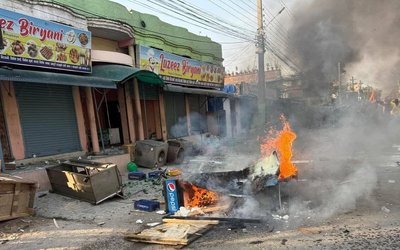More on News





Two months after the first of two major earthquakes hit Nepal, UNICEF is supporting the Ministry of Health and partners to accelerate delivery of essential nutrition services to over 500,000 children and women in the 14 most affected districts through a weeklong campaign.
“The earthquakes destroyed homes and stored food grains, killed livestock, exposed people living in shelters to the hard weather conditions during the monsoon, damaged roads and water sources, as well as overwhelmed the understaffed health care facilities.
All of them have taken a toll on the delivery of health and nutrition services and also expose children to additional health and nutritional risks,” said Mr. Tomoo Hozumi, UNICEF Representative to Nepal. “Transporting essential supplies to the communities living in the remote areas of these districts is posing a great challenge with the setting in of the monsoon rains.”
“In Nepal, even before the emergency, close to four out of 10 children were in a state of malnutrition. Now with these damages, losses and challenges, children aged 6 to 59 months in these earthquake affected districts are at a heightened risk of malnutrition.”
During the Child Nutrition Week, which began 28 June, UNICEF has been supporting the Government of Nepal and partners to scale up the delivery of various nutrition interventions and key messages to
protect the lives of the children. This initiative was necessary to reach the hard to reach children with comprehensive nutrition package, and to increase the coverage of various nutrition interventions in these affected 14 districts. The messages stress the importance of promoting locally available nutritious food as well as nutritional supplements where necessary. Over 10,000 Female Community Health Volunteers, 4,000 Health Workers and others have been rolling out the activities, which include supporting mothers to breastfeed 168,000 children aged 0 to 24 months to ensure that
they grow healthy and do not fall sick with diarrhoea and pneumonia, supporting families to feed locally available Complementary food to 126,000 children aged 6 to 24 months to enable them to develop to their full potential and not fall victim to malnutrition.
Other areas include Conducting community-based screening by using mid-upper arm circumference (MUAC) tapes to quickly measure and identify children with severe acute malnutrition (SAM).
Similarly, providing therapeutic foods – like nutrient-rich peanut paste – and care to 16,500 children with severe acute malnutrition to reduce the risk of their deaths and bring them back to healthy growth and development and distributing vitamin A, iron and folic acid, and other micronutrient supplements to 362,000 children under five years of age as well as 185,000 pregnant and breastfeeding women as necessary to strengthen the children’s immune system and ensure that women have healthy pregnancies and healthy babies.
These interventions build upon the continuous efforts by Government of Nepal, UNICEF and its national and international partners following the earthquakes to improve the lives of children and women in the 14 most affected districts. Current achievements include.
All essential nutrition supplies needed for the initial three-month response period have been delivered in the 14 most affected districts targeting up to 600,000 under-five children, pregnant women and lactating mothers. Over 60,000 children aged 6 to 59 months have been screened, in which 1,572 children were identified with moderate acute malnutrition and 191 were identified as with severe acute malnutrition (SAM). Children with SAM have been admitted for therapeutic feeding in outpatient therapeutic programme centers.
According to a press release issued by UNICEF, over 35,000 mothers received counseling on exclusive breastfeeding as well as the risks of artificial feeding.
“Proper nutrition and care is crucial in giving a child the best start in life,” said Mr. Hozumi. “It is especially important during an emergency, where children are more vulnerable to diseases and conditions that can have a long-lasting negative impact on their lives. We need to do everything we can to prevent the surge of malnutrition among children during the monsoon season, which even in the best of times is very challenging in terms of diseases and malnutrition of children.”





